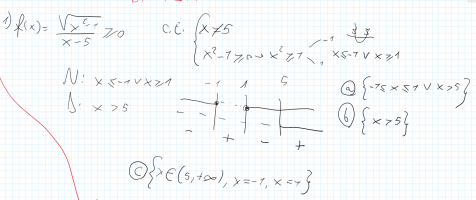I have solved this inequality correctly I think. I am inclined to say the result is A but option C also makes me think. I know (-1,1) is not included in the domain but according to the little "scheme" I drew, the function is positive in that interval and therefore I would consider it as part of the result. If this is not the case, then I assume that for inequalities the solution ALWAYS has to be according to the domain, regardless of what the scheme says. Is that the case?
(I am not that good at math and I am just trying to pass a test and I don't have a lot of time, this is why I approach math exercises in such a mechanical way, with a learnt method, rather than reasoning. Knowing the reasoning behind the steps would help me remember the steps for sure tho)

(I am not that good at math and I am just trying to pass a test and I don't have a lot of time, this is why I approach math exercises in such a mechanical way, with a learnt method, rather than reasoning. Knowing the reasoning behind the steps would help me remember the steps for sure tho)

